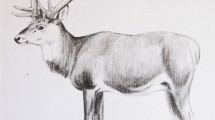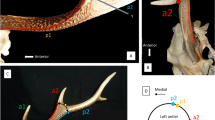Abstract
In 2004, Christian Pitra and co-workers published the first molecular phylogeny of Old World deer which advanced our understanding of the Cervinae immeasurably by demonstrating the non-monophyletic status of the red deer/wapiti group, the chital/hog deer group and the swamp deer/Eld's deer group. Therefore, many conspicuous external features—antler complexity, mane and rump-patch development—turned out to be related not to phylogeny as much as to climatic-related lifestyle factors. At a lower level, molecular genetics has reinforced some conclusions drawn on the basis of morphology or behaviour. Striking examples are the divisions between mainland and Japanese sika and between northern and southern forms of Japanese sika. In this paper, I will look at the species living in what Pitra et al. (Evolution and phylogeny of old world deer. Mol Phylogenet Evol 33:880–895, 2004) identified as the heartland of cervine evolution: eastern Eurasia. I will consider the two species groups in this region that seem to crystallize both the problems of cervine classification and the ways in which the new sources of evidence have opened up new avenues of inquiry.



Similar content being viewed by others
References
Allen GM (1940) Mammals of China and Mongolia, vol 2. American Museum of Natural History, New York
Balakrishnan CN, Montfort SL, Gaur A, Singh L, Sorenson MD (2003) Phylogeography and conservation genetics of Eld's deer (Cervus eldi). Mol Ecol 12:1–10
Banwell DB (1999) The Sika. Halcyon, Auckland
Braun A, Groves CP, Grubb P, Yang QS, Xia L (2001) Catalogue of the Musée Heude collection of mammal skulls. Acta Zootaxon Sin 26:608–660
Brooke V (1878) On the classification of the Cervidae, with a synopsis of the existing species. Proc Zool Soc Lond 1878:883–928
Cook CE, Wang Y, Sensabaugh G (1999) A mitochondrial control region and cytochrome b phylogeny of sika deer (Cervus nippon) and report of tandem repeats in the control region. Mol Phylogenet Evol 12:47–56
Dao VT (1985) Scientific results of some mammal surveys in North Vietnam (1957–1971). Scientific and Technical Publishing House, Hanoi (in Vietnamese)
Dobroruka L (1959) Formosa-sika, Cervus nippon taiouanus Blyth, 1860. Säugetierkundl Mitt 7:172
Dobroruka L (1960) Über Cervus nippon mantchuricus Swinhoe, 1864. Zoologischer Anzeiger 165:70–74
Dolan JM (1988) A deer of many lands: a guide to the subspecies of the red deer Cervus elaphus L. Zoonooz 62(10):4–34
Dolan JM, Killmar LE (1988) The shou, Cervus elaphus wallichi Cuvier, 1825, a rare and little-known cervid, with remarks on three additional Asiatic elaphines. Zool Gart NF 58:84–96
Ellerman JR, Morrison-Scott TCS (1951) Checklist of Palaearctic and Indian mammals 1758 to 1946. Trustees of the British Museum, London
Engelmann C (1938) Über die Grosssäuger Szetschwans, Sikongs und Osttibets. Z Säugetierkd 13:1–76
Flerov KK (1952) Fauna of USSR. Mammals, vol 1, no 2. Musk deer and deer. Academy of Sciences of the USSR, Moscow (Translation: 1980, Israel Program for Scientific Translations. National Science Foundation and Smithsonian Institution, Washington)
Geist V (1998) Deer of the world: their evolution, behaviour, and ecology. Stackpole Books, Mechanicsburg, PA
Goodman M, Porter CA, Czelusniak J, Page SL, Schneider H, Shoshani J, Gunnell G, Groves CP (1998) Toward a phylogenetic classification of Primates based on DNA evidence complemented by fossil evidence. Mol Phylogenet Evol 9:585–598
Goodman SJ, Tamate HB, Wilson R, Nagata J, Tatsuzawa S, Swanson GM, Pemberton JM, McCullough DR (2001) Bottlenecks, drift and differentiation: the population structure and demographic history of sika deer (Cervus nippon) in the Japanese archipelago. Mol Biol 10:1357–1370
Groves CP, Grubb P (1987) Relationships of living deer. In: Wemmer CM, (ed) Biology and management of the Cervidae. Research symposia of the National Zoological Park. Smithsonian Institution, Washingon, DC, USA, pp 21–80
Groves CP, Smeenk C (1978) On the type material of Cervus nippon Temminck, 1836; with a revision of sika deer from the main Japanese islands. Zool Meded Leiden 53:11–28
Guo Z, Chen E, Wang Y (1978) A new subspecies of sika deer from Sichuan—Cervus nippon sichuanicus subsp. nov. Acta Zool Sin 24:187–192
Heptner VG, Nasimovich AA, Bannikov AG (1961) Mammals of the Soviet Union, vol 1. Artiodactyla and Perissodactyla (Translation: 1998, Smithsonian Institution and National Science Foundation, Washington)
Heude PM (1884) Catalogue des Cerfs Tachetées (Sikas) du Musée de Zi-ka-wei, ou Notes Préparatoires à la Monographie de ce Groupe. Shanghai Musée de Zi-ka-wei
Hodgson BH (1841) Notes on the Cervus elaphus (?) of the Sal Forest of Nepal. Hodie, C. Affinis, nob. J R Asiat Soc Bengal Sci 10:721–724
Imaizumi Y (1960) Coloured illustrations of the mammals of Japan (in Japanese). Osaka Hoikusha Publishing Co. Ltd., Japan
Imaizumi Y (1970) Description of a new species of Cervus from the Tsushima Islands, Japan, with a revision of the subgenus Sika based on clinical analysis. Bull Nat Sci Mus Tokyo 13:185–193
Liu XH, Wang YQ, Liu ZQ, Zu KY (2003) Phylogenetic relationships of Cervinae based on sequence of mitochondrial cytochrome b gene. Zool Res 1:27–33
Ludt CJ, Schroder W, Rottmann O, Kuehn R (2004) Mitochondrial DNA phylogeography of red deer (Cervus elaphus). Mol Phylogenet Evol 31:1064–1083
Lydekker R (1909) On a new race of deer from Sze-chuan. Proc Zool Soc Lond 1909:533–540
Lydekker R (1915) Catalogue of the ungulate mammals in the British Museum (Natural History), vol IV. Artiodactyla, Families Cervidae (Deer), Tragulidae (Chevrotains), Camelidae (Camels and Llamas), Suidae (Pigs and Peccaries), and Hippopotamidae (Hippopotamuses). British Museum Trustees, London
Matsumoto M, Nishinakagawa H, Otsuka J (1984) Morphometrical study on the skull of Cervus pulchellus, Cervus nippon mageshimae and Cervus nippon yakushimae. J Mammal Soc Japan 10:41–52
Meijaard E, Groves CP (2004) Morphometrical relationships between South-east Asian deer (Cervidae, tribe Cervini): evolutionary and biogeographic implications. J Zool Lond 263:179–196
Nagata J, Masuda R, Tamata HB, Hamasaki SI, Ochiai K, Asada M, Tatsuzawa S, Suda K, Tado H, Yoshida MC (1999) Two genetically distinct lineages of the sika deer, Cervus nippon, in Japanese islands: comparison of mitochondrial D-loop region sequences. Mol Phylogenet Evol 13:511–519
Pitra C, Fickel J, Meijaard E, Groves CP (2004) Evolution and phylogeny of old world deer. Mol Phylogenet Evol 33:880–895
Pocock RI (1912) On a rare stag (Cervus wallichii) from Nepal recently presented to the Zoological Society by His Majesty King George. Proc Zool Soc Lond: 558–575
Pocock RI (1943) The larger deer of British India. Part II. J Bombay Nat Hist Soc 43:553–572
Polziehn RO, Strobeck C (2002) A phylogenetic comparison of red deer and wapiti using mitochondrial DNA. Mol Phylogenet Evol 22:342–356
Randi E, Mucci N, Claro-Hergueta F, Bonnet A, Douzery EJP (2001) A mitochondrial DNA control region phylogeny of the Cervinae: speciation in Cervus and implications for conservation. Anim Conserv 4:1–11
Thomas O (1918) The nomenclature of the geographical forms of the Panolia deer (Rucervus eldi and its relatives). J Bombay Nat Hist Soc 25:363–367
Acknowledgements
This paper is dedicated to Professor Christian Pitra on the occasion of his 65th birthday, 29 April 2005.
Author information
Authors and Affiliations
Corresponding author
Rights and permissions
About this article
Cite this article
Groves, C. The genus Cervus in eastern Eurasia. Eur J Wildl Res 52, 14–22 (2006). https://doi.org/10.1007/s10344-005-0011-5
Received:
Accepted:
Published:
Issue Date:
DOI: https://doi.org/10.1007/s10344-005-0011-5




